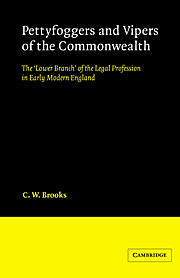 Pettyfoggers and Vipers of the Commonwealth
Pettyfoggers and Vipers of the Commonwealth Book contents
- Frontmatter
- Contents
- List of tables and figures
- Preface
- Abbreviations
- 1 Introduction
- 2 Lawyers and the royal courts in London during the reign of Elizabeth
- 3 The legal profession in the provinces
- 4 The increase in litigation
- 5 The causes of the increase in litigation
- 6 The increase in litigation and the legal profession
- 7 The attitudes of layman and attempts at reform
- 8 Clerkship, the inns of chancery, and legal education
- 9 Private practice
- 10 Public office and politics
- 11 Fees and incomes
- 12 Conclusion
- Appendix: Analysis of the social status of litigants in King's Bench and Common Pleas, 1560–1640
- Notes
- Select bibliography
- Index
- CAMBRIDGE STUDIES IN ENGLISH LEGAL HISTORY
- Frontmatter
- Contents
- List of tables and figures
- Preface
- Abbreviations
- 1 Introduction
- 2 Lawyers and the royal courts in London during the reign of Elizabeth
- 3 The legal profession in the provinces
- 4 The increase in litigation
- 5 The causes of the increase in litigation
- 6 The increase in litigation and the legal profession
- 7 The attitudes of layman and attempts at reform
- 8 Clerkship, the inns of chancery, and legal education
- 9 Private practice
- 10 Public office and politics
- 11 Fees and incomes
- 12 Conclusion
- Appendix: Analysis of the social status of litigants in King's Bench and Common Pleas, 1560–1640
- Notes
- Select bibliography
- Index
- CAMBRIDGE STUDIES IN ENGLISH LEGAL HISTORY
Summary
In concluding this study of the lower branch of the legal profession, two related problems need to be addressed. First, the place of the early modern practitioners within the wider context of the history of the professions in general must be established. Second, the various pieces presented in earlier chapters must be brought together into a more concise picture of the role of these lawyers in late-sixteenth-and early-seventeenth-century society.
Amongst social theorists and modern historians, it is a common place that, since the Industrial Revolution, the professions have come to occupy a uniquely important place in the social and political life of modern capitalist society. Some have gone so far as to welcome this development as heralding new occupational structures and new class interests. Others are more doubtful about the benefits of the process of ‘ professionalization’. But few would question that the emphasis on specialized training, self-regulation, and sense of vocation which are characteristic of professional men have greatly influenced modern attitudes towards work and social structure. As Talcott Parsons has put it, the importance of the professions in the twentieth century is unique in history.
In the most general sense, this comment is no doubt true enough. The decline of the landed interest and of traditional vocational structures associated with craft guilds, coupled with the emergence of groups such as engineers and scientists who are associated with modern technology, has indeed given professionals an important role. However, from the point of view of the historian, this twentieth-century familiarity with professions has had the effect of severely distorting our perspectives on their development.
- Type
- Chapter
- Information
- Pettyfoggers and Vipers of the CommonwealthThe 'Lower Branch' of the Legal Profession in Early Modern England, pp. 263 - 280Publisher: Cambridge University PressPrint publication year: 1986
